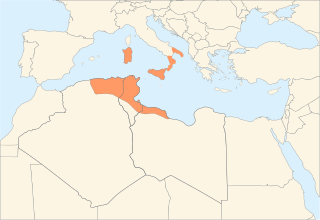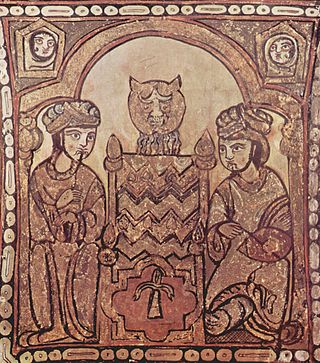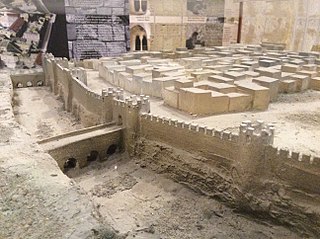The 820s decade ran from January 1, 820, to December 31, 829.
The 860s decade ran from January 1, 860, to December 31, 869.
The 870s decade ran from January 1, 870, to December 31, 879.
The 880s decade ran from January 1, 880, to December 31, 889.
The 900s decade ran from January 1, 900, to December 31, 909.
Year 877 (DCCCLXXVII) was a common year starting on Tuesday of the Julian calendar.

Year 900 (CM) was a leap year starting on Tuesday of the Julian calendar.

Year 953 (CMLIII) was a common year starting on Saturday of the Julian calendar.

The Aghlabid dynasty was an Arab dynasty centered in Ifriqiya from 800 to 909 that conquered parts of Sicily, Southern Italy, and possibly Sardinia, nominally as vassals of the Abbasid Caliphate. The Aghlabids were from the tribe of Banu Tamim and adhered to the Mu'tazilite rationalist doctrine within Hanafi Sunni Islam, which they imposed as the state doctrine of Ifriqiya. They ruled until 909 when they were conquered by the new power of the Fatimids.

Abu Ishaq Ibrahim II ibn Ahmad was the Emir of Ifriqiya. He ruled from 875 until his abdication in 902. After the demise of his brother, Ibrahim was endorsed as emir where he took steps to improve safety in his domain and secured the development of commercial activities. He improved public works, such as building a vast reservoir, erecting walls as well as the development of mosques and his Raqqada palace.
Caltavuturo is a town and comune in the Metropolitan City of Palermo, Sicily, Italy. The neighboring comunes are Polizzi Generosa, Scillato and Sclafani Bagni.

Leo of Tripoli, known in Arabic as Rashīq al-Wardāmī, and Ghulām Zurāfa, was a Greek renegade and fleet commander for the Abbasid Caliphate in the early tenth century. He is most notable for his sack of Thessalonica, the Byzantine Empire's second city, in 904.

The history of Islam in Sicily and southern Italy began with Arab colonization in Sicily, at Mazara, which was captured in 827. The subsequent rule of Sicily and Malta started in the 10th century. The Emirate of Sicily lasted from 831 until 1061, and controlled the whole island by 902. Though Sicily was the primary Muslim stronghold in Italy, some temporary footholds, the most substantial of which was the port city of Bari, were established on the mainland peninsula, especially in mainland southern Italy, though Arab raids, mainly those of Muhammad I ibn al-Aghlab, reached as far north as Naples, Rome and the northern region of Piedmont. The Arab raids were part of a larger struggle for power in Italy and Europe, with Christian Byzantine, Frankish, Norman and indigenous Italian forces also competing for control. Arabs were sometimes allied with various Christian factions against other factions.

The Muslim conquest of Sicily began in June 827 and lasted until 902, when the last major Byzantine stronghold on the island, Taormina, fell. Isolated fortresses remained in Byzantine hands until 965, but the island was henceforth under Muslim rule until conquered in turn by the Normans in the 11th century.

The sack of Thessalonica refers to the capture, and subsequent sack, of the Byzantine city of Thessalonica by the Abbasid Caliphate in the year 904, led by Leo of Tripoli, a privateer and Muslim convert.

The siege of Syracuse from 877 to 878 led to the fall of the city of Syracuse, the Byzantine capital of Sicily, to the Aghlabids. The siege lasted from August 877 to 21 May 878 when the city, effectively left without assistance by the central Byzantine government, was taken by the Aghlabid forces.

Constantine Phokas was a Byzantine aristocrat and general.

The siege of Melite was the capture of the Byzantine city of Melite by an invading Aghlabid army in 870 AD. The siege was initially led by Halaf al-Hādim, a renowned engineer, but he was killed and replaced by Sawāda Ibn Muḥammad. The city withstood the siege for some weeks or months, but it ultimately fell to the invaders, and its inhabitants were massacred and the city was sacked.
The Battle of Caltavuturo was fought in 881 or 882 between the Byzantine Empire and the Aghlabid emirate of Ifriqiya, during the Muslim conquest of Sicily. It was a major Byzantine victory, although it could not reverse the Muslim conquest of Sicily.

The siege of Taormina in 902 ended the conquest of the Byzantine city of Taormina, in northeastern Sicily, by the Aghlabids. The campaign was led by the deposed Aghlabid emir, Ibrahim II, as a form of armed pilgrimage and holy war. Ibrahim's forces defeated the Byzantine garrison in a hard-fought battle in front of the city walls, and laid siege to the city. Left unsupported by the Byzantine government, Taormina capitulated on 1 August. The population was massacred or sold into slavery. The fall of this last major Byzantine stronghold signalled the completion of the Muslim conquest of Sicily, which had been ongoing since the 820s, although some minor Byzantine outposts survived until the 960s.










